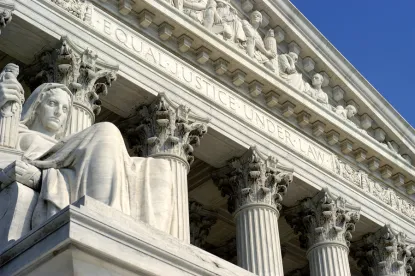Briefs defending the Federal Energy Regulatory Commission’s demand response (“DR”) pricing policy were filed in the Supreme Court of the United States on July 9, 2015. The arguments set forth in those briefs will determine whether FERC’s robust support of DR as a player in competitive wholesale electric energy markets will survive legal scrutiny. Notably, the brief submitted by the Solicitor General of the United States (“SG) on behalf of FERC reflects interesting and somewhat surprising choices in defense of the Commission’s policy which D.C. Circuit had characterized as regulatory overreach and overturned.
That policy, set forth in FERC Order No. 745 and subsequent supplements, required wholesale electric markets regulated under the Federal Power Act (“FPA”) to pay for energy provided as DR on a basis that the Commission determined was equivalent to what is paid for energy provided by generators in those same markets. Generators won their challenge to Order No. 745 before the D.C. Circuit in a 2-1 decision in Electric Power Supply Association et al. v. FERC, 753 F. 3rd 216 (D.C. Cir., 2014), in which the majority held that the Commission had acted beyond its jurisdiction under the FPA and also had failed to address concerns raised by a dissenting Commissioner. The D.C. Circuit stayed the effect of its decision pending judicial review. The Supreme Court granted certiorari earlier this year on both issues identified in the D.C. Circuit’s opinion in response to petitions filed by the SG and by a group of pro-DR interests led by EnerNOC, Inc., which were consolidated for review.
With respect to the issue of whether FERC had exceeded its jurisdiction, it is not surprising that the SG’s brief supported FERC’s contention that Order No. 745 was within the jurisdiction granted by the FPA to regulate wholesale electric markets because participation by DR providers would necessarily affect quantities and prices for electricity delivered in those markets. Nor was it unexpected that the government’s brief argues that FERC’s policy judgment is entitled to Chevron deference in the absence of a specific statutory prohibition of its actions. Nonetheless, what the SG chose to argue and chose not to argue provides some sense as to the strengths and weaknesses of the government’s case.
Predictably, the SG’s jurisdictional argument adopts much of the rationale offered by Judge Edwards of the D.C. Circuit in his vigorous and lengthy dissent from the majority’s opinion below. Judge Edwards argued that provision of DR in a wholesale market, rather than being the absence of a retail sale and thus non-jurisdictional as a decision not to consume electricity as the majority had held, was arguably something that FERC could treat as a “sale for resale” within the meaning of FPA Section 201(e) given the statute’s ambiguity as to the specific issue and thus within Chevron deference. SG Brief at 45. The SG brief also relies upon Judge Edwards’ dissent in its argument that FERC clearly explained its reasoning in how it dealt with the concerns regarding DR compensation raised by Commissioner Moeller in his dissent to Order No. 745. SG Brief at 46-60.
An apparent anomaly is the SG’s attempt to refute the D.C. Circuit’s concern that, “…FERC’s interpretation of the FPA would authorize it to regulate markets in generation inputs like ‘steel, fuel and labor.’” SG Brief at 29. The brief dismisses the concern briefly in a paragraph, stating that, “…wholesale-market operators do not themselves purchase or make payments for fuel or steel.” Id. Yet, if wholesale market operators do not purchase fuel or steel, generators, as participants in wholesale electric markets, surely do make such purchases – particularly fuel. Indeed, FERC has ongoing inquiries as to the relationship between the natural gas and wholesale electric markets. See FERC Docket AD12-12-000. It is not clear why the SG chose to go down this path.
The thrust of the government’s main argument is that FERC has to be able to regulate DR in wholesale electric markets under the FPA because the states obviously cannot do so. Implicit in this argument is a rejection of the premise accepted by the D.C. Circuit that DR is essentially a retail – and thus a non-jurisdictional – activity because the decision not to consume electricity is made by an end-user, the sales to which are subject to state regulation. Acceptance of this premise, according to the SG, would mean conceding the existence of a regulatory vacuum, analogous to the famous Attleboro gap that Part II of the FPA was designed to fill. Such a regulatory gap, the SG argues, could not have been the intent of Congress. However, this argument does not address the possibility that Congress might not have considered the issue at all in enacting the FPA. Arguing that the Commission’s decision survives under Chevron deference stretches that concept to cover administrative agencies applying possibly their expertise to invent solutions not addressed by Congress, as distinct from resolving ambiguities in what Congress has actually legislated.
The SG’s reliance upon Nantahala Power & Light Co. v. Thornburg, 476 U.S. 953 (1986) and Mississippi Power & Light v. Mississippi, 487 U.S. 354 (1988) to support the notion that exercise of federal wholesale electric regulatory authority in some instances necessarily affects state retail regulation, is likewise subject to question. In both of those precedents, FERC’s determination of reasonableness of contracts affecting wholesale rates was held to be binding on state regulation through federal preemption. The price at which DR is sold in wholesale electric markets is arguably distinguishable because there is no federal preemption involved. States have plenary authority to regulate retail rates, including the authority to achieve their own policy goals in the structure of retail rates. Arguably, states might have the authority to prohibit or limit certain forms of DR on grounds of interference with state policy goals (as acknowledged by the SG Brief at 43), but if states permitted retail customers purchasing electricity subject to their regulation to engage in DR at the retail level, they would be hard pressed to justify prohibiting a decision by a customer to sell such DR into a wholesale market. In that instance, where DR (i.e. a decision to forego consumption of a certain quantity of electricity) is apparently a right exercisable by the retail customer, presumably that customer could decide to monetize the right in wholesale electric markets rather than retail markets. And it would not be a jurisdictional stretch to say that the FPA jurisdiction attaches to the decision to sell the DR in a FERC-regulated market, not to the DR itself, because of the effect on that market.
How the generating interests participating the U.S. Supreme Court will respond to these arguments will be known once they submit their own briefs, now due August 29, 2015. Reply briefs by petitioners are due September 28, 2015.



 />i
/>i

